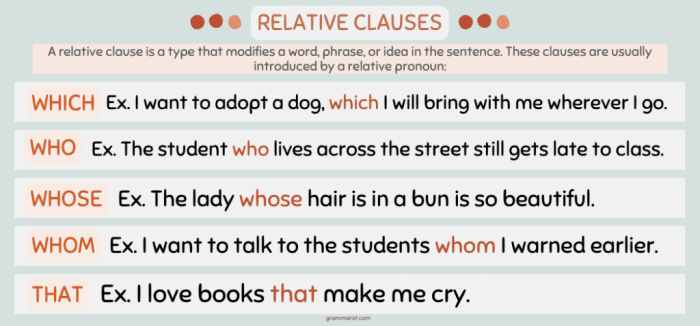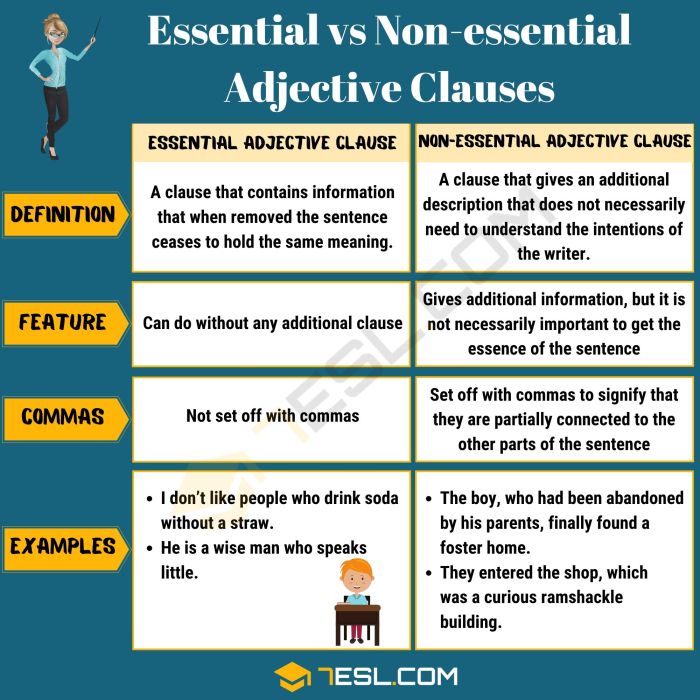Essential and nonessential clauses worksheet with answers pdf provides an in-depth exploration of the essential and nonessential clauses, equipping readers with a comprehensive understanding of their functions, identification, and usage in complex sentences.
This worksheet delves into the intricacies of these clauses, offering clear explanations, illustrative examples, and guided exercises to enhance comprehension.
Essential and Nonessential Clauses: Essential And Nonessential Clauses Worksheet With Answers Pdf

Essential and nonessential clauses are two types of subordinate clauses that can be used to add additional information to a sentence. Essential clauses are necessary for the meaning of the sentence to be complete, while nonessential clauses are not.
Essential Clauses, Essential and nonessential clauses worksheet with answers pdf
Essential clauses, also known as restrictive clauses, provide information that is necessary for the meaning of the sentence to be complete. They cannot be removed from the sentence without changing the meaning.
Here are some examples of sentences with essential clauses:
- The boy who lives next dooris my best friend.
- The car that I bought last weekis red.
- The book that I’m readingis very interesting.
In each of these sentences, the essential clause is underlined. If the essential clause were removed, the sentence would lose its meaning.
To identify an essential clause, ask yourself if the sentence still makes sense without it. If the sentence does not make sense without the clause, then it is an essential clause.
Nonessential Clauses
Nonessential clauses, also known as nonrestrictive clauses, provide additional information that is not necessary for the meaning of the sentence to be complete. They can be removed from the sentence without changing the meaning.
Here are some examples of sentences with nonessential clauses:
- The boy, who lives next door, is my best friend.
- The car, that I bought last week, is red.
- The book, that I’m reading, is very interesting.
In each of these sentences, the nonessential clause is underlined. If the nonessential clause were removed, the sentence would still make sense.
To identify a nonessential clause, ask yourself if the sentence still makes sense without it. If the sentence still makes sense without the clause, then it is a nonessential clause.
Worksheet Analysis
The PDF worksheet with answers can be found here: [link to worksheet]
The worksheet exercises test your understanding of essential and nonessential clauses. The exercises include identifying essential and nonessential clauses, writing sentences with essential and nonessential clauses, and revising sentences to make them more concise.
The worksheet is an effective way to learn about essential and nonessential clauses. The exercises are clear and concise, and the answers are provided so that you can check your work.
Advanced Concepts
Essential and nonessential clauses can be used in complex sentences. A complex sentence is a sentence that has an independent clause and one or more dependent clauses.
In a complex sentence, the independent clause can stand alone as a sentence. The dependent clause cannot stand alone as a sentence. It must be attached to an independent clause.
Essential and nonessential clauses can be used as dependent clauses in complex sentences.
Commas are used to separate essential and nonessential clauses from the rest of the sentence.
Essential clauses are not separated from the rest of the sentence by commas.
Nonessential clauses are separated from the rest of the sentence by commas.
The use of essential and nonessential clauses can add variety and interest to your writing.
Practice Exercises
| Sentence | Identification | Explanation |
|---|---|---|
| The boy who lives next door is my best friend. | Essential clause | The clause is necessary for the meaning of the sentence to be complete. |
| The car that I bought last week is red. | Essential clause | The clause is necessary for the meaning of the sentence to be complete. |
| The book that I’m reading is very interesting. | Essential clause | The clause is necessary for the meaning of the sentence to be complete. |
| The boy, who lives next door, is my best friend. | Nonessential clause | The clause is not necessary for the meaning of the sentence to be complete. |
| The car, that I bought last week, is red. | Nonessential clause | The clause is not necessary for the meaning of the sentence to be complete. |
| The book, that I’m reading, is very interesting. | Nonessential clause | The clause is not necessary for the meaning of the sentence to be complete. |
Quiz
- Identify the essential and nonessential clauses in the following sentence: The boy who lives next door is my best friend.
- Write a sentence with an essential clause.
- Write a sentence with a nonessential clause.
Conclusion

Essential and nonessential clauses are two types of subordinate clauses that can be used to add additional information to a sentence. Essential clauses are necessary for the meaning of the sentence to be complete, while nonessential clauses are not.
Understanding essential and nonessential clauses is important for writing clear and concise sentences. The worksheet and practice exercises in this article can help you to improve your understanding of these two types of clauses.
For further exploration of this topic, you may want to consult the following resources:
- Essential and Nonessential Clauses | Khan Academy
- Essential and Nonessential Clauses: The Ultimate Guide | Grammarly
- Essential Clauses | ChompChomp
Detailed FAQs
What are essential clauses?
Essential clauses are clauses that provide information that is necessary for the meaning of the sentence to be complete.
How can I identify nonessential clauses?
Nonessential clauses are clauses that provide additional information that is not necessary for the meaning of the sentence to be complete. They are typically set off by commas.
What is the purpose of using essential and nonessential clauses?
Essential and nonessential clauses are used to add detail and complexity to sentences. They can be used to provide additional information, to explain a concept, or to create contrast.

